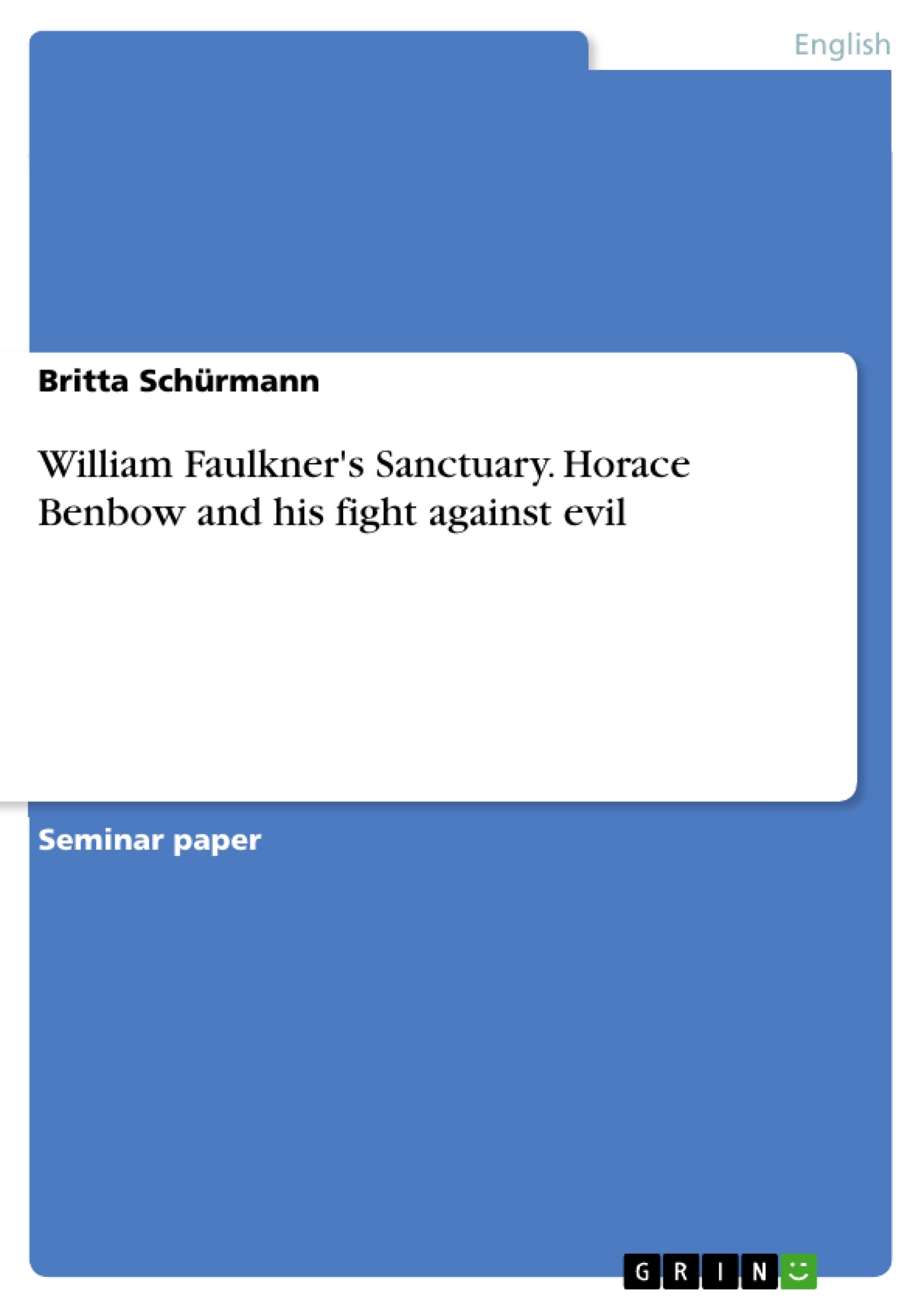In Sanctuary, Horace Benbow desperately tries to help others (and himself) out of unjust situations, but tragically fails in the end with Temple Drake having changed her mind and testifying not against her rapist, Popeye, but against the innocent Goodwin who is then convicted and lynched. Throughout the novel, Horace clings to fair justice and tries to fight any evil he comes across. But as he does not even accept it to be a part of the world, of humanity itself, he is doomed to lose this fight. An analysis of Horace's character regarding his ideals, his relationships and views (on himself, others, the world) is going to explain this statement.
Inhaltsverzeichnis (Table of Contents)
- Introduction
- Horace and his World (and the Real World)
- Horace's Low Self-Esteem and Fear of Failing
- Horace's Relationship to the Female Characters around Him
- Conclusion
Zielsetzung und Themenschwerpunkte (Objectives and Key Themes)
This analysis aims to explore the reasons behind Horace Benbow's failure to combat evil in William Faulkner's Sanctuary. It examines his character, ideals, relationships, and worldview to explain why his attempts at justice are ultimately unsuccessful.
- The nature of good and evil in Faulkner's work
- Horace's idealistic worldview and its limitations
- Horace's relationships with the female characters and their impact on his perception of evil
- The contrast between Horace's world and the "real world" depicted in the novel
- Horace's inability to accept the pervasive nature of evil in humanity
Zusammenfassung der Kapitel (Chapter Summaries)
Introduction: This introductory chapter sets the stage for the analysis of Horace Benbow's character and his struggle against evil in Faulkner's Sanctuary. It highlights Horace's tragic failure to help Temple Drake and Goodwin, emphasizing his inability to confront the pervasive nature of evil within society. The introduction posits that Horace's inability to accept evil as an inherent part of humanity ultimately dooms his efforts to combat injustice.
Horace and his World (and the Real World): This chapter delves into Horace's character, portraying him as an educated, intelligent, yet somewhat passive observer. While he possesses empathy and a strong sense of justice, his idealistic worldview clashes with the harsh realities of the novel's setting. His belief in civilized confrontation and the power of law contrasts sharply with the pervasive corruption and violence surrounding him. The chapter explores Horace's discomfort and physical reactions to confronting evil, suggesting his inability to accept its existence in the "real world".
Schlüsselwörter (Keywords)
William Faulkner, Sanctuary, Horace Benbow, Good vs. Evil, Idealism, Justice, Morality, Southern Gothic, Passivity, Empathy.
Frequently Asked Questions: Analysis of Horace Benbow in Faulkner's Sanctuary
What is the overall focus of this analysis?
This analysis explores why Horace Benbow fails to effectively combat evil in William Faulkner's Sanctuary. It examines his character, beliefs, relationships, and worldview to understand his unsuccessful attempts at justice.
What are the key themes explored in this analysis?
The analysis delves into the nature of good and evil in Faulkner's work, Horace's idealistic worldview and its limitations, his relationships with female characters and their impact, the contrast between his idealized world and the novel's harsh reality, and his inability to accept the pervasive nature of evil.
What is covered in the "Introduction" chapter?
The introduction sets the scene, focusing on Horace Benbow's character and his struggle against evil in Sanctuary. It highlights his failure to help Temple Drake and Goodwin, emphasizing his inability to confront the widespread evil in society. The introduction argues that his inability to accept evil's inherent presence dooms his efforts.
What does the chapter on "Horace and his World (and the Real World)" discuss?
This chapter examines Horace's character as an educated, intelligent, but passive observer. It contrasts his idealistic worldview with the harsh realities of the novel's setting, highlighting the conflict between his belief in civilized confrontation and the surrounding corruption and violence. His discomfort and physical reactions to confronting evil are analyzed, revealing his difficulty in accepting its presence.
What are the chapter summaries about?
The chapter summaries provide a concise overview of the main points and arguments presented in each section of the analysis, offering a structured understanding of the progression of ideas related to Horace Benbow's character and his failures.
What are the objectives of this analysis?
The main objective is to analyze the reasons behind Horace Benbow's failure to combat evil in Sanctuary. This involves examining his character, ideals, relationships, and his overall perception of the world.
What keywords are associated with this analysis?
The keywords include William Faulkner, Sanctuary, Horace Benbow, Good vs. Evil, Idealism, Justice, Morality, Southern Gothic, Passivity, and Empathy.
What is the structure of this document?
The document provides a comprehensive preview including a table of contents, objectives and key themes, chapter summaries, and keywords, offering a structured overview of the analysis of Horace Benbow's character in Faulkner's Sanctuary.
What is the intended audience of this document?
This document is intended for academic use, supporting the structured analysis of themes within Faulkner's Sanctuary.
- Quote paper
- Britta Schürmann (Author), 2012, William Faulkner's Sanctuary. Horace Benbow and his fight against evil, Munich, GRIN Verlag, https://www.grin.com/document/271951



